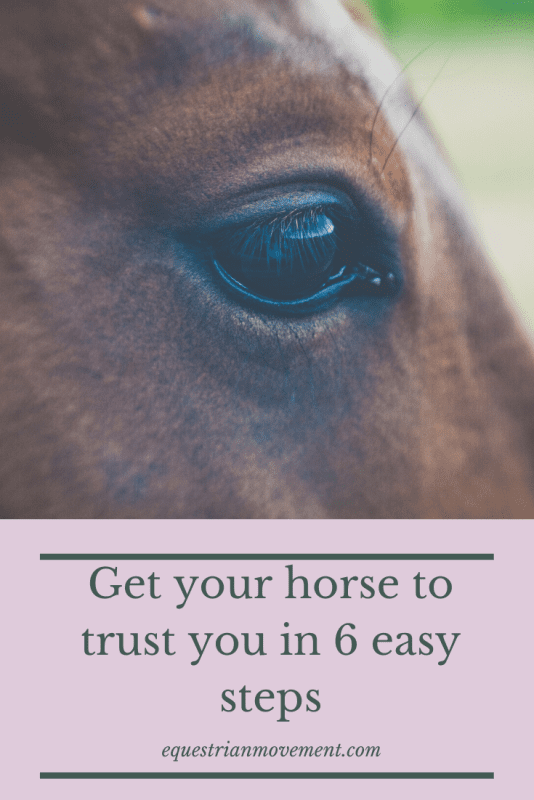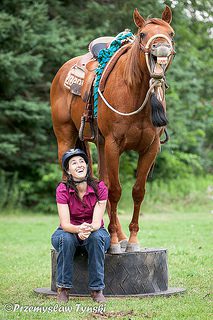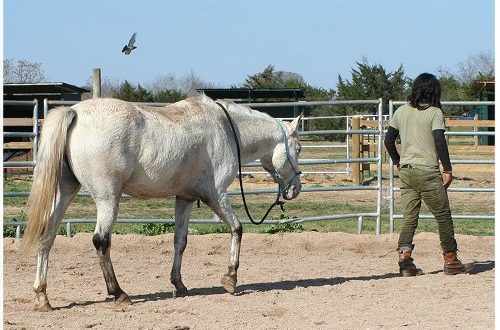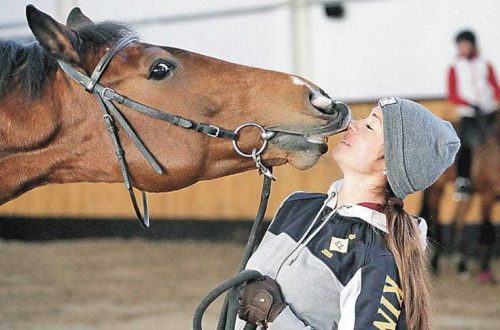
Five Easy Ways to Build Your Horse’s Trust
Five Easy Ways to Build Your Horse’s Trust
Trust is the most important thing in working with a horse. This is the absolute truth. You must trust your horse and your horse must trust you.
Your horse needs to know that you will be able to keep him safe and not ask him to do things he is physically or mentally incapable of doing. You must trust that your horse can act as a partner and be responsible.
If your horse does not trust you, then be prepared to communicate with an animal that will refuse to work, be afraid of “horse-eaters” and give you a lot of unpleasant sensations.
If you do not trust your horse, then your horse will not learn to be responsible, he will not like you, because you are too controlling and acting like a predator. A relationship in which a horse would like to cooperate with you will not develop…
I want to share a few easy ways to get started on building trust.
1. Protect your privacy
The most important step in building trust between you and your horse is to protect your his (!) personal space. I often see people who love to hug their horses, but often end up with the horse pushing them backwards, trying to go “through” the person, pushing him when he wants to go.
The horse must see you as a strong and confident leader who can maintain both his own safety and create a safe environment for himself.
But, if you can’t even protect your space from your horse, then how are you going to protect it from a dire wolf that “hides” behind that bush in the arena or an alligator that is waiting in ambush, ready to jump out from behind a pebble on footpath any minute?!
People often don’t fully realize the huge impact the ability to protect your personal space from your horse has on your horse.
This may surprise you, but in order to protect your space, you have to pay more attention to your feet. DO NOT move your feet, DO NOT retreat! Once you’ve finished the hugging session, you should “push” the horse out of your personal space, not back off and walk away.
If a horse is standing next to you while you are waiting for something, just brush it, etc., and it moves too close to you, you should move it back, but never move your (!) legs.
You can lead the horse with a lead, hand, or otherwise force it out of your personal space. But you must not take a single step with your feet.
You can move your legs when you want to go forward or ask the horse to do something else. You should only allow the horse to enter your personal space when you allow it. The permission is formalized by demonstrating a relaxed posture: move your navel back from the horse – invite him to come closer to you.
If you are facing your horse, your body language is telling him that you are in your personal space and he should not violate it. Only if you relax your posture and invite the horse to come closer can he come closer. Remember: don’t move your feet!
2. Protect your horse
While protecting yourself and your space, you must also protect your horse. This means protecting her from any people, animals, or objects that might hurt her.
This responsibility falls on you from the moment you enter the levada – you need to make sure that no other horse is touching your horse. Even if another horse tries to touch him in a friendly way, you should not let him.
After all, how can your horse trust that you will protect him from a predator if you can’t even get the other horses in the herd to stop touching him?
Your horse needs to see you as a leader. Sometimes I hear stories about horses protecting “their” person from other horses or scary objects. However, while it’s nice that the horse cares for you, it shows that he thinks you need protection. The real leader does not need to be protected – he himself protects the horse, and not vice versa.
If you allow your horse to take on the role of leader, that member of your “herd” who chases other horses away or protects you from scary objects, then you will send a very dangerous message to the horse – you will tell him that you are the follower, not the leader. As a result of the decision, the horse will begin to take over for you.
This can be very dangerous. If you are riding, lunging, leading or playing with the horse, it may turn around, kick, run (including at you), refuse to jump, refuse to move in one direction, etc. After all, now she believes that she is a leader and makes her own decisions, which may be fundamentally different from yours.
3. Set goals
As a protective and respected leader, you will be expected to set goals and objectives for your partnership. Everything you do should be done because you are focused on a specific goal or task. The task can be very simple, like “let’s graze” or “let’s wait for another rider to pass”, or more difficult like “let’s do a couple of changes to the pace”.
Regardless of what you have chosen as your goal, you must understand and be aware of what you are doing, and your horse must know what you expect from him.
For example, if you are grooming a horse in a stall, you set the goal of standing still. If the horse starts to move, you must, without nervousness, tension, discontent, return it to its original place and start cleaning again. You show the horse that he needs to stand at a particular point. No need to hold the horse or pull it, forcing it to stand still. You want the horse to understand the task and complete it of his own free will.
Another example. If you are riding and want to work on the circle, you need to keep your horse on the path of the circle. You can first try to show her the trajectory with your body and legs, slightly prompting the reins. Don’t lead the horse all the time. She must understand the task and stay on the circle. You don’t have to keep her there. Give the horse the opportunity to fulfill your request without any control on your part. Correct, bring it back, but then again let her have the freedom to do the task on her own, without being forced.
You give the task, trusting the horse to follow it, correcting and correcting only as needed. You patiently, persistently correct your horse until he understands the essence of your goal.
Remember that your task must be adequate and reasonable. If something is beyond the power of the horse, then it is foolish to ask him about it and expect that he will be able to cope.
Be adequate in your requirements. It is not fair to ask a horse to stand for an hour while you tug his mane. Instead, ask her to stand for 10 minutes, then take a break, then ask her to stand for 15 minutes, break again, and so on. If your horse is just learning to do air changes, ask for one change and let him walk, then repeat.
Your goals must be achievable!
You can set goals that allow the horse to come up with ideas.
Let’s say your horse is inactive and your goal is to encourage him to trot forward. You give the command, but the horse rises to a gallop. You can take a canter and ride a couple of paces (because the horse answered everything conditionally positive – moved forward), and then correct it by bringing it to a trot. In this way, the horse will not be afraid to offer you his ideas, because you remain soft and calm. You understand that she tried to give an answer, but she simply misunderstood you, and will not be punished.
And here is an example of how the horse does not offer an idea within the framework of the rider’s task, but changes it. The rider asks the horse to turn right, but the horse resists and pulls the reins the other way, turning left. The rider changes the controls to turn left and allows the horse to change the task. The horse changed the task set by the leader.
Be careful! Design the problem, bring it to the horse and don’t let the horse change it!
If you can communicate the task to the horse and encourage him to stick to this task, he will trust you even more. When a dangerous situation arises and you tell the horse that the object is not scary, he will not panic, because he knows that you will not change your thoughts, and after five minutes the object will still not pose a threat.
If you allow your horse to change your tasks, he will assume that you are not completely confident in your decisions. If you meet on your way horse-eater, the horse may not believe you, because he knows that even he can influence your decisions.
4. Acquaintance, expectation, repeated contact

Some horses are naturally more courageous than others, more shy and prone to flight. Horses can become more confident if you introduce them to a variety of things – they associate positive experiences with different objects/environments.
When you encourage a horse to touch various objects, it builds his confidence (of course, if the horse is not hurt or scared).
When you introduce your horse to new things, keep in mind the Natural Horsemanship principle of “Introduce, Expect, Re-Contact”:
1. You are introduced to a new / scary object.
2. As soon as your horse shows the slightest sign of anxiety or an attempt to escape, you stop and wait.
3. You’re waiting at the exact point where your horse started to worry!
4. You wait until your horse asks a question or you notice signs of relaxation.
5. As soon as your horse asks a question or relaxes a bit, you walk away to reward him.
6. Then you return again to once again make contact with the terrible object.
It is important that while you are waiting, the horse is facing the scary object. Or you should keep the object of concern in the same place where he touched the horse and he was frightened. This way, the horse will not learn to run away or back away when it gets scared. You are just waiting at the point where the signs of unrest have appeared.
So, if you start approaching a scary tarp and the horse raises its head high and looks alert, you will stop (perhaps your horse will stop itself) and wait in the same place until the horse lowers its head and assumes a more relaxed posture and / or turn their ear in your direction to ask a question. You will answer her question by stepping back a few steps, pausing, and rewarding the horse. Then you will ask her to move forward again (to take the same steps that the horse was already taking before she got scared).
Another example is when you touch a horse with something new, like a clipper, and you hit a spot where the horse starts to get restless (say, the belly). You do not remove the clipper from the place where the horse began to show anxiety (tailing, raising his head, stomping around, etc.). When the horse relaxes (stops tailing, lowers its head, stands still, etc.), you immediately remove your hand from the clipper. Then you start again, moving the machine over the places where there were no problems, gradually approaching the stomach.
By following this approach, you teach the horse that there is no need for a violent reaction, such as candles, attempts to bite you, hit you, run away, etc., because you are reacting to the slightest cue from him (raising his head, waving his tail, kicking with legs). You also encourage the horse to stand still/relax for the reward.
Just think about it. If a horse is nervous when being saddled, mounted, trimmed, etc., he shows it to you by wagging his tail or raising his head, but then he decides to offer you another answer – to stand still.
If you react by jumping into the saddle quickly, throwing on a saddle pad, tightening the girth, or cutting hard, you will punish (!) the horse for standing still, doing exactly what he was worried about! The correct solution is to reward the horse if it stands still, stepping back. When the horse shows that he has calmed down, you can gradually continue. Over time, the signs of anxiety will disappear for good.
What’s more, your horse will be bigger trust you because you show her that you understand her fears. You are also showing the horse that you have patience and that you will eventually mount, saddle or shave (have your way), but you are ready to do so when he is not nervous.
This means you are a partner and not a dictator to be feared!
Test your relationship and explore new objects: walk on a tarpaulin, near balls, introduce a horse to a clipper, a plastic bag, wave a rope near him, walk with him on poles, on bridges, stand in the water, put the horse on a pedestal or elevation, show her children’s toys, hoops, whatever you can think of! Do not scare her, but interest her.
You can also change the scenery in the arena by rearranging obstacles, potted flowers, bringing different objects to the arena, etc. Your horse needs to stay relaxed even if the environment changes, so try to change routes and environments.
Change is good, it builds confidence – just learn to “acquaint, wait and reconnect.”
5. Interactive game

Once you’ve introduced your horse to a lot of things, it’s important to try to turn some of them into goals or make them part of your game.
This is where you can get creative and think about how you can use your knowledge and skills in challenging games that can help you test the quality of your communication, build trust, and ultimately build a better partnership.
Some ideas:
1. Instead of just walking on the poles, try making half-step stops.
2. Try asking the horse to stand on a pedestal (elevation) with all four legs.
3. Ask the horse to walk sideways over the pole.
4. Ask the horse to turn front/back so that his feet (front or back) are in the hoop on the ground.
5. Let the horse jump over easy low barriers at large or in a springgarten near you.
6. Ask the horse to put one foot on the splint.
7. Restrain the horse through a corridor of flower pots or boxes.
8. Walk in a figure of eight around flower boxes, barrels, or other objects.
9. Lead the horse between closely spaced poles, bedside tables – see how narrow the passage can be to keep the horse calm (great for practicing loading into a horse carrier).
10 Walk on a tarp or shower curtain.
11 Loading into a horse carrier. Can you half load your horse into a horse carrier? How about full loading and unloading?
Use these 5 tips when spending time with your horse, and you will soon have a partner with “iron” nerves who will follow you through fire and into water!
Lindsey Partridge (source); translation by Valeria Smirnova.





